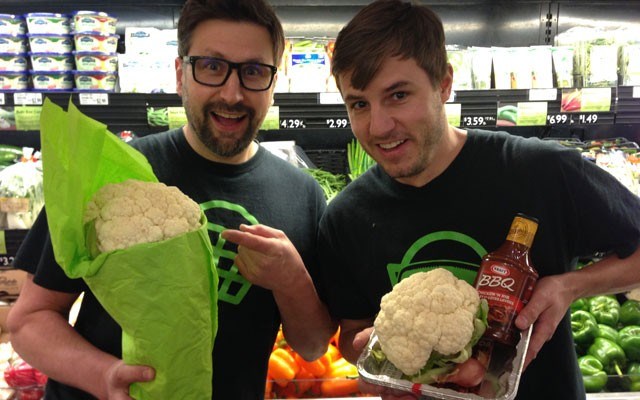My neighbour was excited the other day when I told her that since we're moving, I'm bequeathing her my giant garden box. "Oh good," she said. "I'm going to grow cauliflower!"
Buffalo wings made with cauliflower. Cauliflower-crust pizza. Cauliflower tacos. Cauliflower Alfredo.
Cauliflower's excellent taste and nutritional value plus its versatility (it's a great substitute for meat and gluten) have made this once overlooked vegetable a hot item lately. Ergo my neighbour's gardening plan.
But couple that trend line with headlines and tweets about cauliflowers hitting $7, $8, even $10 a head that were elbowing for space with stories about the Canadian dollar taking the plunge while holding hands with oil, and suddenly cauliflower's been trotted out as poster child for the drowning loonie, West Texas crude, killer grocery prices, or all of the above. Brent Bambury on CBC's Day 6 took it to the ultimate, equating the price of six cauliflowers to the price of a barrel of oil.
Shocked by $8 cauliflower? Get used to it, and more high fruit and veggie prices, says Yahoo.com. $10 cauliflower just the beginning, warns the Financial Post, as if all food prices will double.
Seriously?
Not to say food prices aren't predicted to go up. Reports from grocers, restaurant associations and consumer groups all say they will. But is The Case of the Crazy Cauliflower Costs really the best indicator?
Something about that whole story angle stunk like... well, like boiling cauliflower. So I dialed up managers at two Whistler grocery stores to see what was up, and soon learned how nuanced this grocery pricing thing really is.
First, I was surprised The Grocery Store hasn't seen any big spikes in cauliflower prices, despite supply challenges.
"Typically, what we see in the produce market is any time there's something like a storm in Florida, or a drought, or a wind storm where stuff gets damaged, the inventory that's available is of a poorer quality and there's less of it, so the price goes up because there is still the same (demand) within North America," says Mike Groot, produce manager at The Grocery Store.
That's exactly what happened to cauliflower. Frost in California, where we get most of our cauliflower from in winter, hit crops hard. Then fields were drowned in rain due to El Niño.
While prices for groceries — the tinned and packaged goods in the middle of the store — haven't gone up so far due to the exchange rate, Scott Aldrich expects they will.
"I got an email from Canada Bread, our bread supplier, and Weston, so I know their prices are going to go up Feb. 1, but I don't think it's directly related to the dollar," says Scott, the store's grocery manager. "Every year we have the commodity adjustments they do, and they always seem to raise their prices around this time of year."
But since most grocery items come from the States, he expects prices will eventually rise. However, he won't be searching out other suppliers for lower prices.
"I stay loyal to the people I buy from because you usually get more discounts and more deals in the long run by sticking with someone you do business with on a regular basis," he says. Besides, customers can't find the products we're used to if suppliers change.
At Nesters Market, store manager Bruce Stewart (who never eats cauliflower at home because it tastes like old socks to him) says they did see a crazy spike around Christmas when prices basically doubled to about $7 a pound due to that Californian weather-based supply crunch. Things have since levelled back out.
But when it comes to other prices tied to the Canadian dollar, they've generally gone up, despite built-in cushioning.
"The short answer is, yes, the dollar has affected us — in some cases," says Bruce. But since wholesalers will average out prices for some products, like dry goods, over a period of months, price increases aren't cut and dried.
"They're not going to change their prices every time there's a dollar change. They have a built-in cushion for that," he says. "Then at some point, suppliers have to make an adjustment, and then we'd see an increase or decrease and take the necessary steps in our prices as well to keep our margin similar to what it was.
"We don't always go up at all, we don't always go up right away, but it does impact us."
It's a fool's game to predict the future, but safe to say that the low-flying loonie will impact our grocery bills in 2016. But according to the Food Institute at the University of Guelph, it will likely be a two to four per cent increase, depending on where you live in Canada — not a 200 or 300 per cent increase as the cauliflower myth alludes.
As for parsing future news and tweets on cauliflower or any topic, check out a fine article by Christie Aschwanden on some of the pratfalls that plague data interpretation and hard science on fivethirtyeight.com, a site created by statistician, author and SXSW favourite Nate Silver. What started as a political polling aggregate site now covers more general statistical analysis and, by association, how to better think critically.
You might get saturated with incoming noise but you can never suffer from too many analytical skills. Or, if you believe the trendies, from too much cauliflower.
Glenda Bartosh is an award-winning journalist who believes that critically analyzing news is more important than ever with the closure and consolidation of so many newsrooms.




